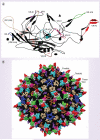Adeno-associated virus structural biology as a tool in vector development
- PMID: 24533032
- PMCID: PMC3921901
- DOI: 10.2217/fvl.13.112
Adeno-associated virus structural biology as a tool in vector development
Abstract
Adeno-associated viruses (AAVs) have become important therapeutic gene delivery vectors in recent years. However, there are challenges, including intractable tissues/cell types and pre-existing immune responses, which need to be overcome for full realization of this system. This review addresses strategies aimed at improving AAV efficacy in the clinic through the creation of hybrid vectors that display altered or more targeted specific tissue tropisms, while also escaping recognition from host-derived neutralizing antibodies. Characterization of these viruses with respect to serotypes contributing to their capsid, using available 3D structures, enables the identification of regions critical for particular tropism and antigenic phenotypes. Structural information also allows for rational design of vectors with specific targeted tropisms for improved therapeutic efficacy.
Keywords: adeno-associated virus; capsid structure; chimera; directed evolution; gene therapy; rational design; tissue tropism.
Figures






References
-
- Mingozzi F, High KA. Therapeutic in vivo gene transfer for genetic disease using AAV: progress and challenges. Nat. Rev. Genet. 2011;12(5):341–355. - PubMed
-
- Yanez RJ, Porter AC. Therapeutic gene targeting. Gene Ther. 1998;5(2):149–159. - PubMed
-
- Peng KW. Strategies for targeting therapeutic gene delivery. Mol. Med. Today. 1999;5(10):448–453. - PubMed
-
- Raper SE, Chirmule N, Lee FS, et al. Fatal systemic inflammatory response syndrome in a ornithine transcarbamylase deficient patient following adenoviral gene transfer. 80. Mol. Genet. Metab. 2003;(1–2):148–158. - PubMed
Grants and funding
LinkOut - more resources
Full Text Sources
Other Literature Sources
